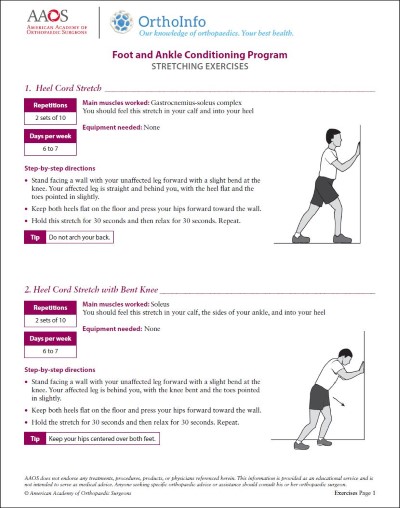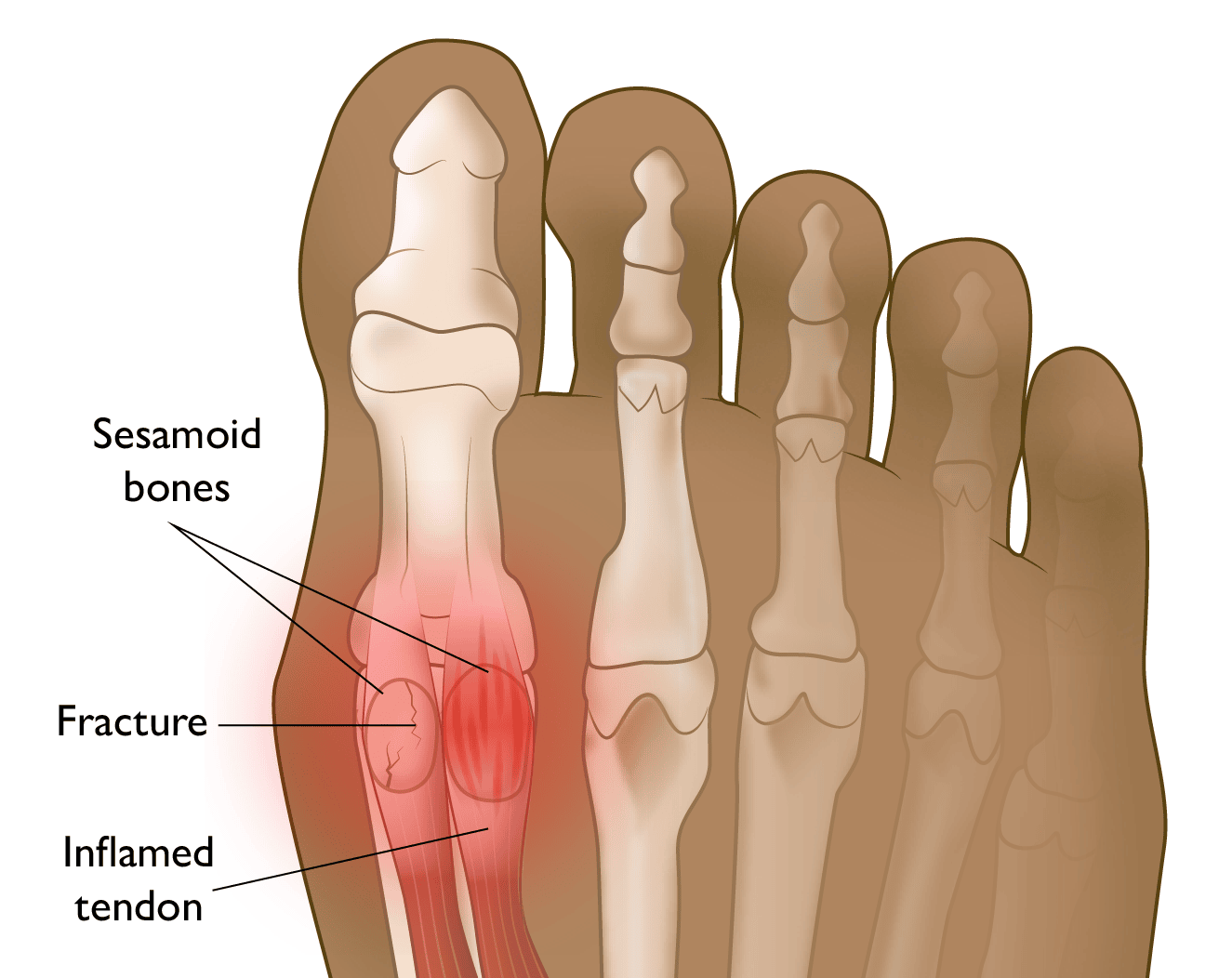Diseases & Conditions
Sesamoiditis and Sesamoid Fracture
Most bones in the human body are connected to each other at joints. But there are a few bones that are not connected to any other bone. Instead, they are connected only to tendons or are embedded in (set into and surrounded by) muscle. These are the sesamoids.
- The kneecap (patella) is the largest sesamoid.
- Two other very small sesamoids, each about the size of a kernel of corn, are found in the bottom of the forefoot (front of the foot). They are located near the big toe — one on the outer side of the foot, the other closer to the middle of the foot.
This article focuses on the sesamoids in the foot. To learn more about conditions of the kneecap in adults, read Patellar (Kneecap) Fractures, Patellofemoral Arthritis, or Patellar Tendon Tear.
Anatomy
- The two sesamoid bones are located under the big toe joint on the plantar (bottom) surface of the foot.
- The big toe flexor tendons are attached to both of the sesamoid bones.
- The sesamoid bones are connected to each other by ligaments and a very strong plantar plate.
Description
Sesamoids act like pulleys. They provide a smooth surface for the tendons to slide over, increasing the ability of the tendons to transmit muscle forces. The sesamoids in the forefoot also assist with weightbearing and help elevate the bones of the big toe.
Like other bones, sesamoids can fracture (break) due to an acute injury or repetitive stress (overuse).
Also, the tendons surrounding the sesamoids can become irritated or inflamed. This is called sesamoiditis, and it is a form of tendinitis. It is common among ballet dancers, runners, and baseball catchers.
Symptoms
- Pain is focused under the big toe on the ball of the foot:
- With sesamoiditis, pain may develop gradually.
- With a sesamoid fracture, you will feel pain immediately after a hyperextension injury to the big toe (the toe is bent backward).
- You may or may not have swelling and bruising.
- You may have a hard time bending and straightening the big toe.
- You may feel pain when you bend and straighten the big toe.
Doctor Examination
Physical Examination
Your doctor will:
- Examine your foot and big toe, looking for tenderness that is localized to (only felt in the area of) the sesamoid bones.
- Evaluate your active range of motion of the joints around the big toe and sesamoid bones.
- Possibly gently bend your big toe up toward the top of your foot to see if your pain worsens.
Imaging Tests
X-rays. Your doctor will request X-rays of the forefoot to ensure a proper diagnosis.
In some people, the sesamoid bone that is closer to the center of the foot (the medial sesamoid) has two parts (bipartite). Because the edges of a bipartite medial sesamoid are usually smooth, and the edges of a fractured sesamoid are usually jagged, an X-ray is useful in making an accurate diagnosis.
Your doctor may also request X-rays of the other foot to compare the bone structures.
Bone scan. If the X-rays of the injured foot appear normal, your doctor may order a bone scan, which can show areas of bone irritation, even if there is not a fracture.
Magnetic resonance imaging (MRI) scan. An MRI is usually not needed to diagnose sesamoiditis or a sesamoid fracture. However, if X-rays do not diagnose the problem and if conservative (nonsurgical) treatments do not improve your symptoms, your doctor might order an MRI. MRI scans can show inflammation around the sesamoids or a subtle sesamoid stress fracture that is not visible on X-rays
Treatment
Treatment is generally conservative (nonsurgical). However, if conservative treatments do not relieve symptoms, your doctor may recommend surgery to remove the sesamoid bone.
Nonsurgical Treatment
For sesamoiditis:
- Stop the activity causing the pain. Rest the foot. Your doctor may request a period of non-weightbearing or pain-free weightbearing (meaning you put weight on the foot only in ways that do not cause pain).
- Take aspirin or ibuprofen to relieve the pain.
- Rest and ice the sole (bottom) of your feet. Do not apply ice directly to the skin; use an ice pack or wrap the ice in a towel.
- Wear soft-soled, low-heeled shoes. Stiff-soled shoes like clogs may also be comfortable.
- Use a felt cushioning pad to relieve stress.
- Return to activity gradually. Continue to wear a cushioning pad of dense foam rubber under the sesamoids to support them.
- Avoid activities that put your weight on the balls of the feet.
- Tape the big toe so that it remains bent slightly downward (plantar flexion).
- Your doctor may recommend an injection of a steroid medication to reduce swelling.
- If symptoms continue, you may need to wear a removable short leg-fracture brace for 4 to 6 weeks.
For a fracture of the sesamoid:
- You will need to wear a stiff-soled shoe or a short leg-fracture brace.
- Your doctor may tape the joint to limit movement of the big toe.
- You may have to wear a J-shaped pad around the area of the sesamoid to relieve pressure as the fracture heals.
- Pain relievers such as aspirin or ibuprofen may be recommended.
- It may take several months for the discomfort to subside.
- Cushioning pads or other orthotic devices are often helpful as the fracture heals.
Surgery
Surgery may be recommended for:
- Longstanding sesamoiditis that has failed to improve with nonsurgical treatment
- A sesamoid fracture that is displaced, meaning the bone is broken and the pieces of bone are not correctly aligned
- A sesamoid fracture that is not healing (fractures that do not heal are called nonunions)
Surgery for a displaced sesamoid fracture may involve repairing the broken bone with heavy suture (stitching) material.
Surgery for sesamoid pain often involves partial or complete removal of one of the sesamoid bones.
Recovery
Recovery from sesamoiditis or a sesamoid fracture depends on the severity of the problem as well as the symptoms.
Recovery can take a long time, with multiple weeks or months of wearing a cast and not putting any weight on the foot. This is because every step you take puts tremendous forces on the ligaments and sesamoid bones in the front of the foot.
Fortunately, most sesamoid problems go away on their own without surgery, and when surgery is needed, it is successful at relieving pain from troublesome sesamoids.
Contributed and/or Updated by
Peer-Reviewed by
AAOS does not endorse any treatments, procedures, products, or physicians referenced herein. This information is provided as an educational service and is not intended to serve as medical advice. Anyone seeking specific orthopaedic advice or assistance should consult his or her orthopaedic surgeon, or locate one in your area through the AAOS Find an Orthopaedist program on this website.








